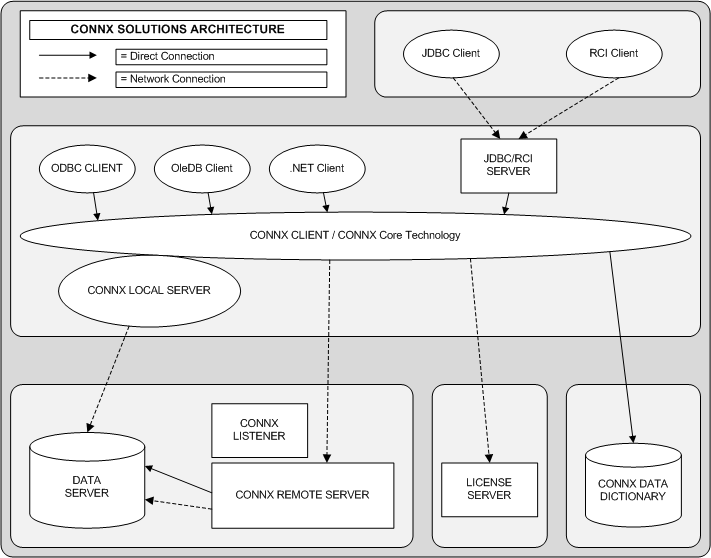CONNX has positioned itself in the marketplace as "Simplified Data Access" for over 20 years But what does "Simplified Data Access" really mean?
Real-time, read/write, SQL access to non-relational and relational data sources, using open data access standards (ODBC, OLE DB, JDBC and .NET).
Connecting to multiple databases, using virtually any ODBC/OLE DB standards-based compliant tool/application.
Integrating multiple disparate data sources no matter where they reside, giving a single SQL view of the data as if it exists in a single relational database.
No disruption to existing systems or extensive programming.
This high-level "view" of CONNX helps to explain how it's done.
Here is a selection of relational and legacy ISAM/hierarchical data sources that CONNX supports:
|
RELATIONAL |
DB2, SqlServer, Oracle, MySQL, Sybase, Informix |
|
|
|
|
HIERACHICAL w/ Record Locking |
Oracle DBMS |
|
|
|
|
ISAM with Transaction support ISAM with Record Locking ISAM with File Locking ISAM with Journaling |
ADABAS, RDB VSAM, CISAM DataFlex RMS |
It is difficult to provide end users a consistent data access interface because different data sources have different external capabilities (such as record locking). A significant development effort would be required to extract a single value from both legacy systems data and direct modern relational API. CONNX provides end users a consistent interface to access their data no matter what the source, shielding the user from the complexity, development and quality assurance costs while providing consistent access methods and functionality across all the supported DBMS systems.

Figure 1. Organizational chart of CONNX Client and Server Components
As Figure 1 shows, CONNX uses a client/server based networked architecture. The CONNX client can be installed on every desktop in the organization or only on a select number of machines that serve data through a web interface or SOA application.
CONNX supports a variety of enterprise organizational models.
If all components reside on the same machine, it may be possible to use either a special in-memory pipe for faster communication, or the operating system loop-back device for ultra-fast communications.
CONNX supports the following access methods:
ODBC
OLEDB
.NET
JDBC
RCI/ Embedded (currently only available to ADABAS users)
All the access methods will route through the client and then to a server which has the most direct contact with any back-end database.
A CONNX server may either be a process separate from the CONNX Client or it may be a DLL/library extension to the CONNX Client. Usually non-relational ISAM databases are implemented in a separate CONNX Remote server process and relational databases are implemented as DLL /library extensions to the CONNX Client. Any supported database with an API that services a network protocol will be implemented as a DLL/library extension to the CONNX Client. The workload is about the same whether using a DLL/library extension or a remote server .
The CONNX client and server perform the following distinct functions:
|
CONNX CLIENT |
Data Conversion SQL to native translation Metadata lookups (requires CDD access) Query Plan creation Data Joining
|
|
CONNX SERVER |
Physical Data Access Indexed data filtering Non-indexed data filtering Distributed Data Joining
|
The DLL/library extension workload is determined by the capabilities of the back-end database:
|
Relational data source |
Filtering and physical data access is off-loaded to the relational database rather than being done by the CONNX client
|
|
CONNX Remote server process (usually a legacy ISAM database) |
CONNX server is responsible for all of the work listed above in the CONNX server column.
|
The CONNX Remote server contains a CONNX Listener component, a separate process that spawns the correct type of independent server processes to service user requests. The CONNX Listener requires a minimal amount of system resources.
The JDBC/RCI server can be considered a CONNX client with a listener attached, with the additional functionality and protocol support needed by JDBC and RCI applications. The JDBC/RCI server supports multiple threads of execution and directly links to the end user's CONNX application if they share the same machine.
The CONNX License server service is a networked application that combines the elements of both a listener and a server. The CONNX License server requires a minimal amount of system resources.
The CONNX Client and CONNX License server service are available on Windows, Linux, Linux Z-Frame, AIX, Solaris, HPUX-RISC, and HPUX-Itanium. Because the CONNX CDD manager and license configuration utilities are only available on Windows, CONNX requires at least one Windows machine to create and manage CDDs and to install and configure CONNX licenses. Windows and UNIX have separate CONNX client configurations and configuration utilities.